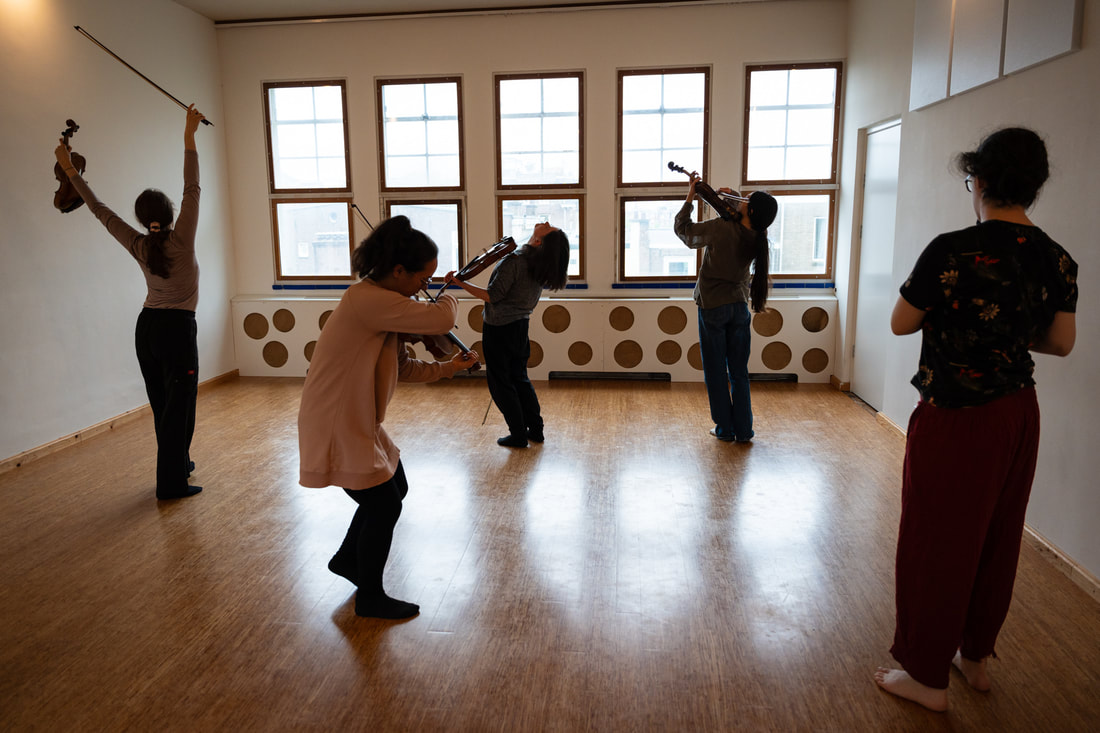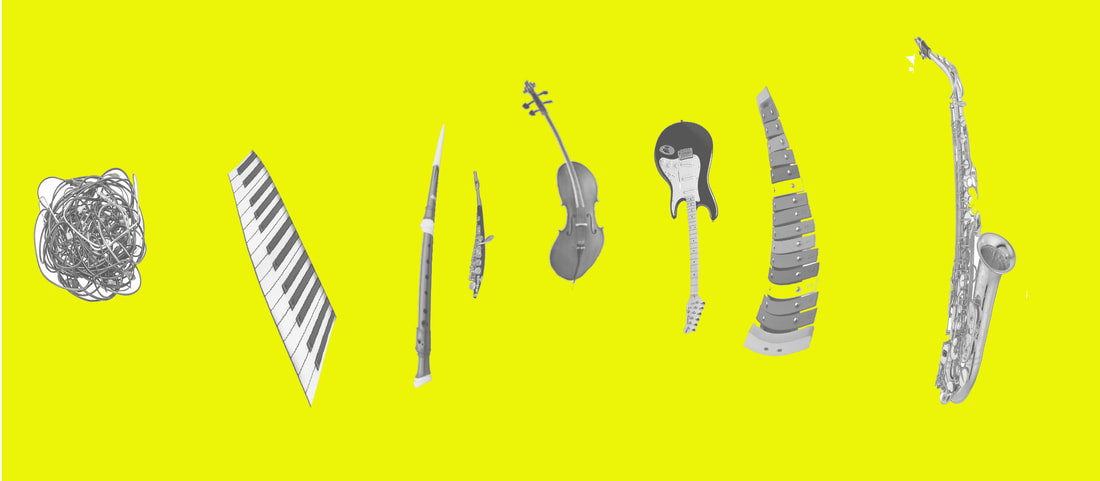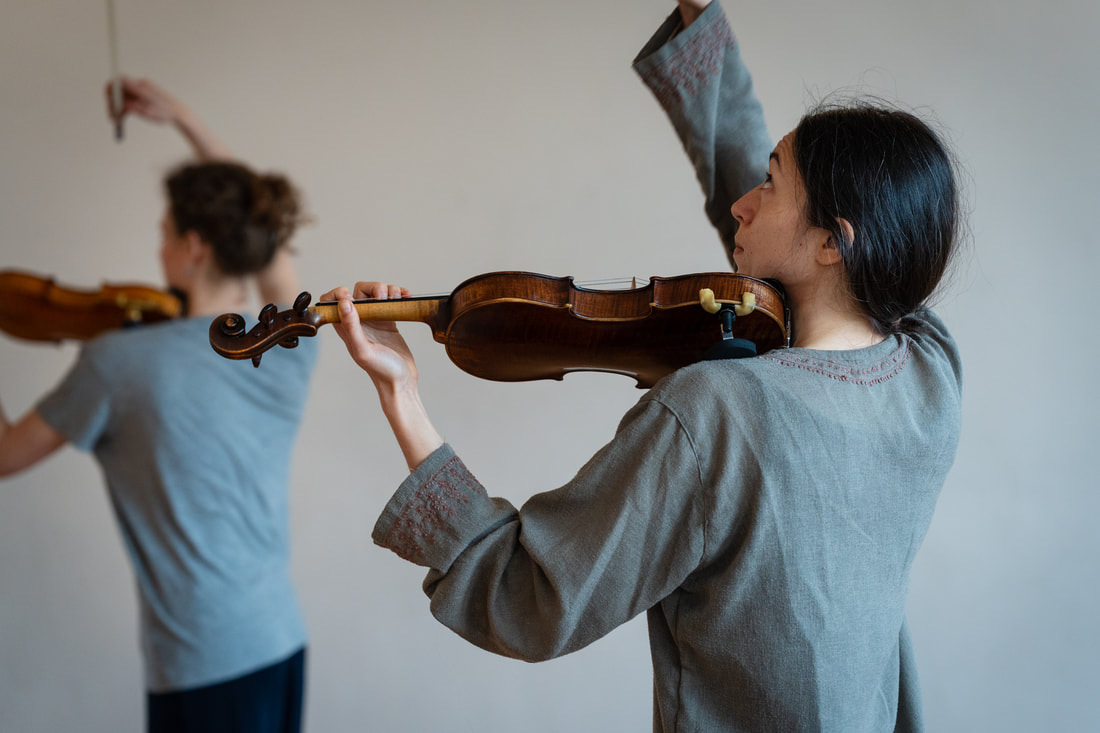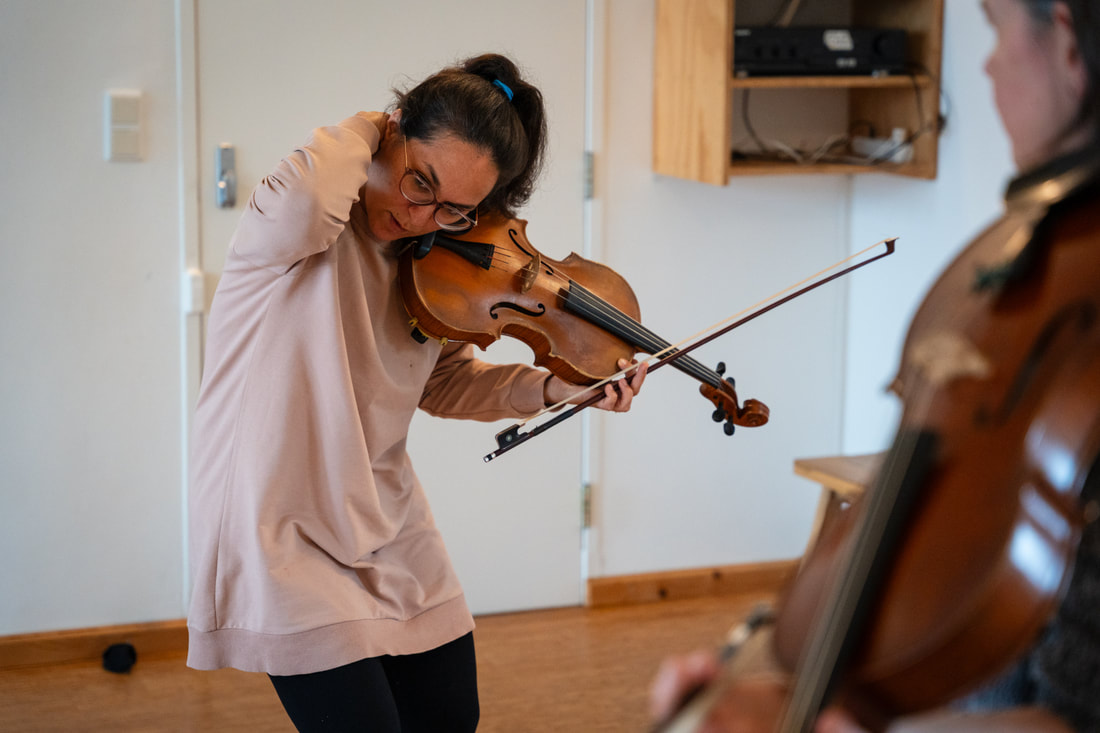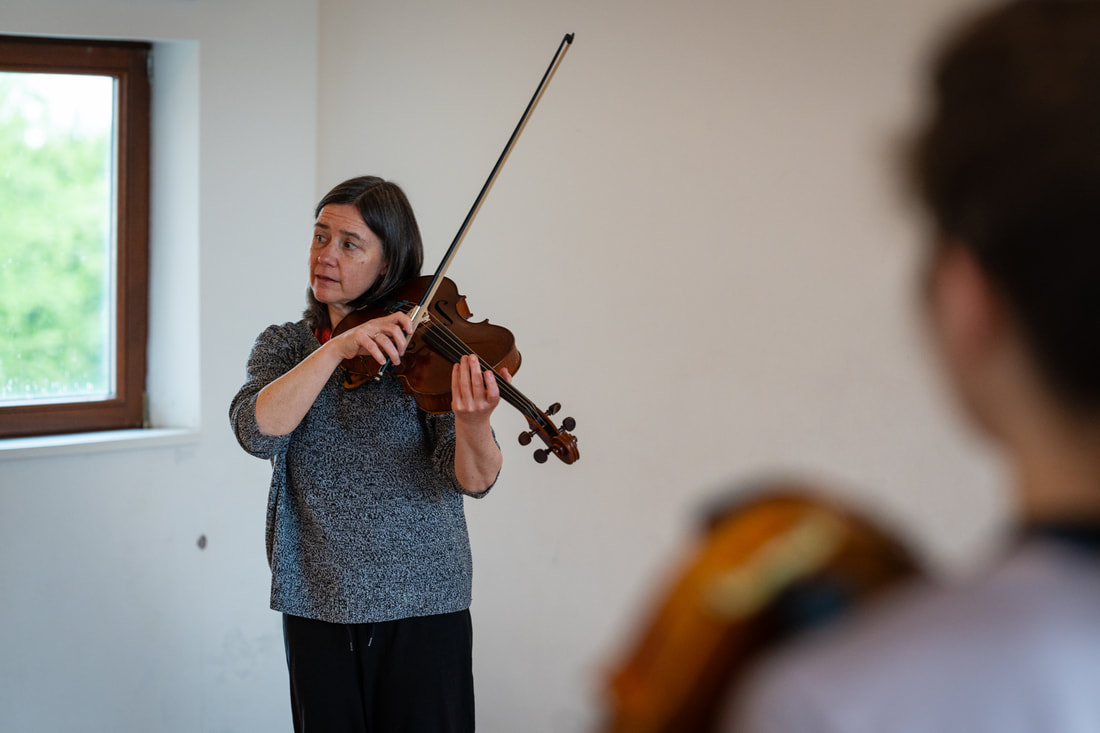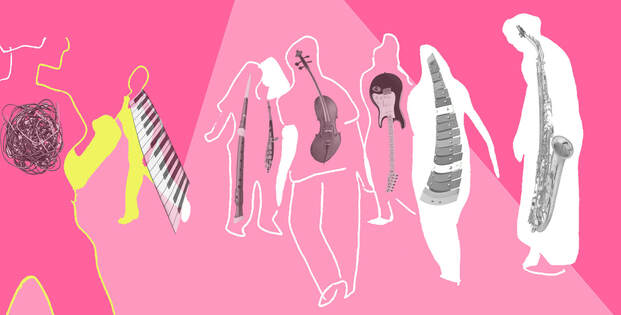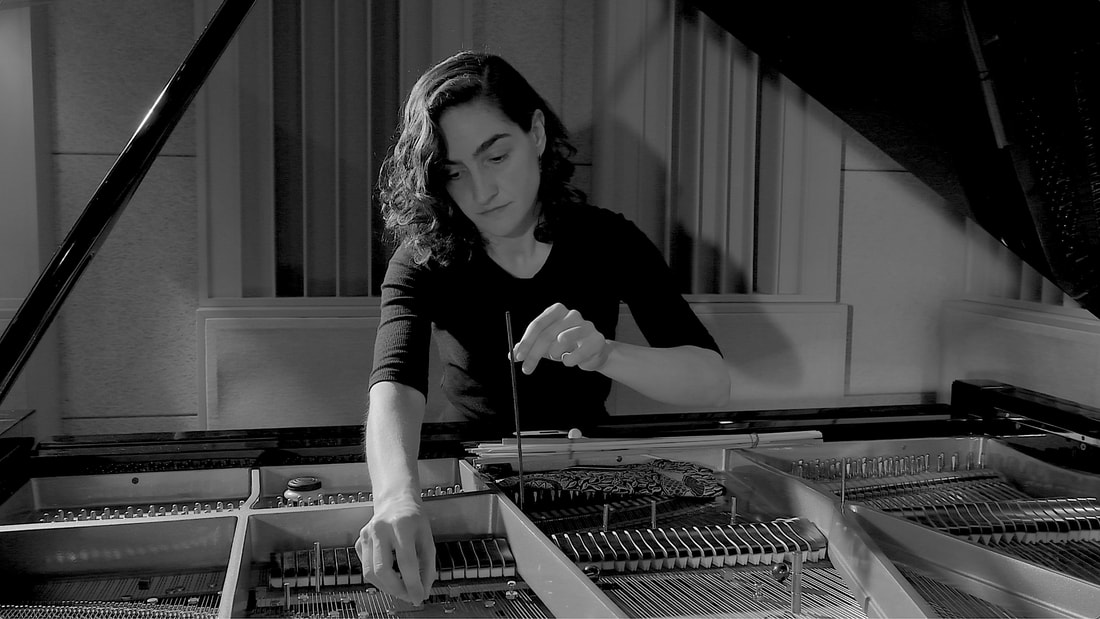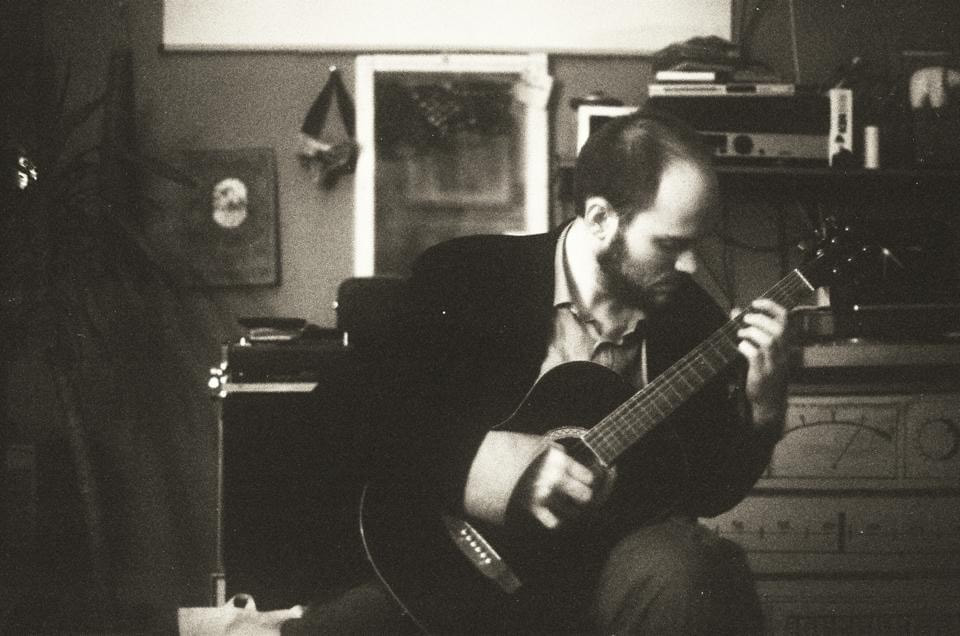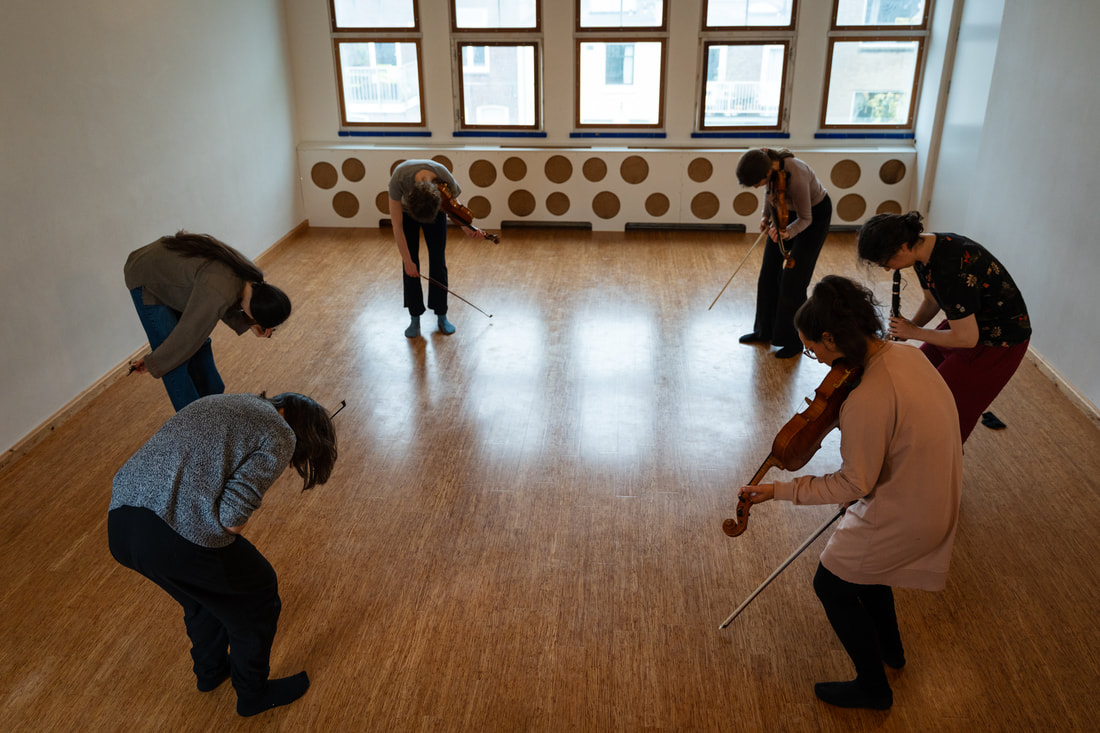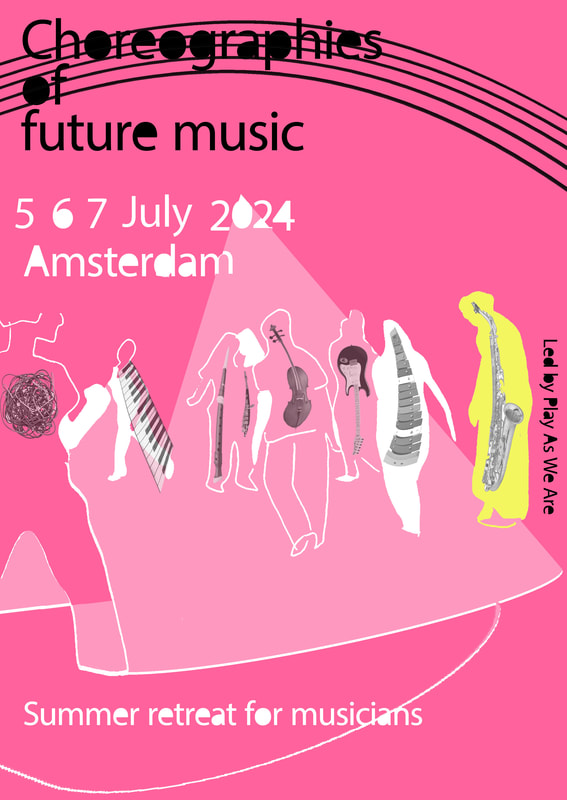When?
July Fri 5, Sat 6, Sun 7 2024
Where? Amsterdam, NL
For who?
Musicians of all kinds,
all instruments or voices,
all levels of experience and (self)education
Led by Play As We Are and guest practitioners (tbc)
To register and book go here
July Fri 5, Sat 6, Sun 7 2024
Where? Amsterdam, NL
For who?
Musicians of all kinds,
all instruments or voices,
all levels of experience and (self)education
Led by Play As We Are and guest practitioners (tbc)
To register and book go here
|
|
Play As We Are 2024 summer retreat for musicians:
Choreographies of
future music
This summer, PAWA focusses on choreographies of practices, groups, experiments.
‘Choreography’ can mean setting dance moves to counts (typical of the 19th century), but it can also mean composing and recomposing movement as an artful practice
in space over time.
What are the choreographies of your
playing or rehearsing?
How do you perceive everyday movement
as a choreography of objects that includes you?
What is the future of (your) music when choreography brings
new awareness to the body moving the sound?
Choreographies of
future music
This summer, PAWA focusses on choreographies of practices, groups, experiments.
‘Choreography’ can mean setting dance moves to counts (typical of the 19th century), but it can also mean composing and recomposing movement as an artful practice
in space over time.
What are the choreographies of your
playing or rehearsing?
How do you perceive everyday movement
as a choreography of objects that includes you?
What is the future of (your) music when choreography brings
new awareness to the body moving the sound?
What you will do
during these three days?
* Learn through practical sessions based on Maya, Alex and Ali’s specialisms in somatic movement, Laban/Bartenieff Movement System, mindfulness, dance-based improvisation:
Ali will lead explorations in spatial directions connected to
how the body grows and shrinks with breath.
She is interested in how choosing directions and moving between
‘spatial pulls’ affects communication with sound.
Alex will teach exercises that bring awareness to our inner experience,
and how this sensing moves from internal to external and back again.
We will use musical scores from the Moving Strings repertoire
to explore how this works in practice.
Maya will lead practical exercises, applications of Bartenieff Fundamentals, such as Thigh Lift, Arm Circle, Rotation, different Patterns of Body Organization as well as Basic Body Actions, in playing an musical instrument or singing. She is curious how these exercises affect ones 'regular' playing movements and sound, and how they could expand towards an a choreography while/next to playing.
* Engage in individual and group creative practices, learn extracts of Moving Strings repertoire.
* Have the chance to be seen, see others and listen to in playful,
exploratory, non-judgemental ways.
* Have the space to challenge yourself, develop your personal practice,
work on a creative task you bring with you.
* Experience two guests who will share their practices which involve movement, sound and performance-making.
* Have the time to connect with your instrument, self and others, and the enviroments.
during these three days?
* Learn through practical sessions based on Maya, Alex and Ali’s specialisms in somatic movement, Laban/Bartenieff Movement System, mindfulness, dance-based improvisation:
Ali will lead explorations in spatial directions connected to
how the body grows and shrinks with breath.
She is interested in how choosing directions and moving between
‘spatial pulls’ affects communication with sound.
Alex will teach exercises that bring awareness to our inner experience,
and how this sensing moves from internal to external and back again.
We will use musical scores from the Moving Strings repertoire
to explore how this works in practice.
Maya will lead practical exercises, applications of Bartenieff Fundamentals, such as Thigh Lift, Arm Circle, Rotation, different Patterns of Body Organization as well as Basic Body Actions, in playing an musical instrument or singing. She is curious how these exercises affect ones 'regular' playing movements and sound, and how they could expand towards an a choreography while/next to playing.
* Engage in individual and group creative practices, learn extracts of Moving Strings repertoire.
* Have the chance to be seen, see others and listen to in playful,
exploratory, non-judgemental ways.
* Have the space to challenge yourself, develop your personal practice,
work on a creative task you bring with you.
* Experience two guests who will share their practices which involve movement, sound and performance-making.
* Have the time to connect with your instrument, self and others, and the enviroments.
Why?
The world of music is changing.
Alongside the traditional practices (classical, jazz, contemporary, pop etc.) a new practice is developing where the performer is not just an interpreter or maker, but a character on the stage. Today's and tomorrow's performers relate to their bodies and the body of the instrument as part of the creation. Movements of playing and expression become part of the performance.
Movement on and off the stage have become dramatic tools, as well as the performance space - its acoustics, visual characteristics and volume.
Performance spaces are both backgrounds and partners in the performance itself, and the relationship with the audience is getting closer, maybe even more necessary than ever.
This retreat responds and contributes to these needs of the professional field through a focus on ‘choreographies’ as a way to re-centre the body and movement,
within the context of musicianship.
The world of music is changing.
Alongside the traditional practices (classical, jazz, contemporary, pop etc.) a new practice is developing where the performer is not just an interpreter or maker, but a character on the stage. Today's and tomorrow's performers relate to their bodies and the body of the instrument as part of the creation. Movements of playing and expression become part of the performance.
Movement on and off the stage have become dramatic tools, as well as the performance space - its acoustics, visual characteristics and volume.
Performance spaces are both backgrounds and partners in the performance itself, and the relationship with the audience is getting closer, maybe even more necessary than ever.
This retreat responds and contributes to these needs of the professional field through a focus on ‘choreographies’ as a way to re-centre the body and movement,
within the context of musicianship.
Schedule
This years schedule is divided in 4 catagories:
INFORMATION: PAWA team teaching (Ali, Alex, Maya, together/individually).
INSPIRATION: guest teacher / learning choreography.
APPLICATION: how to apply what we learned and got inspired from in our own practice,
for our own needs, including time to create.
SHARING/COMMUNITY: performance, talk, presentation or just having dinner together.
Friday July 5th
14 - 15.30 INFORMATION: PAWA team teaching
16 - 17.30 INSPIRATION: learning Moving Strings repertoire
18.30 - 21 INSPIRATION and COMMUNITY:
a participatory evening with a guest teacher Fulya Uçanok
Saturday July 6th
10 - 12.30 INFORMATION: PAWA team teaching
14 - 16 APPLICATION
17.30 - 20 INSPIRATION and COMMUNITY:
a participatory evening with a guest teacher Michael Picknett
Sunday July 7th
10.30 - 12.30 INFORMATION: PAWA team teaching
14 - 16 APPLICATION
16 - 17 REFLECTION
This years schedule is divided in 4 catagories:
INFORMATION: PAWA team teaching (Ali, Alex, Maya, together/individually).
INSPIRATION: guest teacher / learning choreography.
APPLICATION: how to apply what we learned and got inspired from in our own practice,
for our own needs, including time to create.
SHARING/COMMUNITY: performance, talk, presentation or just having dinner together.
Friday July 5th
14 - 15.30 INFORMATION: PAWA team teaching
16 - 17.30 INSPIRATION: learning Moving Strings repertoire
18.30 - 21 INSPIRATION and COMMUNITY:
a participatory evening with a guest teacher Fulya Uçanok
Saturday July 6th
10 - 12.30 INFORMATION: PAWA team teaching
14 - 16 APPLICATION
17.30 - 20 INSPIRATION and COMMUNITY:
a participatory evening with a guest teacher Michael Picknett
Sunday July 7th
10.30 - 12.30 INFORMATION: PAWA team teaching
14 - 16 APPLICATION
16 - 17 REFLECTION
Guest Practitionairs
We are excited to host Fulya Uçanok and Michael Picknett as guests on PAWA's retreat. They will each share their work and lead exploration sessions with the retreats participants.
Fulya Uçanok
We are excited to host Fulya Uçanok and Michael Picknett as guests on PAWA's retreat. They will each share their work and lead exploration sessions with the retreats participants.
Fulya Uçanok
Fulya Uçanok
Fulya Uçanok is an electroacoustic musician and pianist; improvising and composing. Her work takes forms of composition, score-based or improvised performance, and artistic research. In her practice she works with everyday objects, acoustic pianos coupled with a variety of objects (utilizing inside-piano technique), electronic processing, generated electronics, and field recordings. She completed her Ph.D. at the Sonic Arts Department of Center for Advanced Studies in Music— Istanbul Technical University. Her dissertation is titled “Towards a Response-able Com-position Practice: Entangling with Humans, More-than-humans and Materials”.
Her interest lies in sympoietic, response-able sonic practices with humans, more-than-humans, and physical materials (musical instruments). Currently her practice focuses on instrument-human collaborations, through new materialist and feminist strands of thought. She investigates interfaces of relation within social sound engagements focusing on embodied explorations for listening, improvising and composing; where she explores weaving theoretical, sensory, and movement-based forms of thinking and expression into the sonic process.
Aside from her composition and performance practice, she is equally interested in creating, being and sharing in environments for listening and making with those who come from different experiences and backgrounds (from musical and non-musical, in and outside the academia). These communal teaching/learning environments are important spaces where her sonic thinking and artistic research is informed socially, culturally and politically.
www.fulyaucanok.com
https://www.facebook.com/fulya.ucanok.9
https://www.instagram.com/fulya_ucanok/
Fulya Uçanok is an electroacoustic musician and pianist; improvising and composing. Her work takes forms of composition, score-based or improvised performance, and artistic research. In her practice she works with everyday objects, acoustic pianos coupled with a variety of objects (utilizing inside-piano technique), electronic processing, generated electronics, and field recordings. She completed her Ph.D. at the Sonic Arts Department of Center for Advanced Studies in Music— Istanbul Technical University. Her dissertation is titled “Towards a Response-able Com-position Practice: Entangling with Humans, More-than-humans and Materials”.
Her interest lies in sympoietic, response-able sonic practices with humans, more-than-humans, and physical materials (musical instruments). Currently her practice focuses on instrument-human collaborations, through new materialist and feminist strands of thought. She investigates interfaces of relation within social sound engagements focusing on embodied explorations for listening, improvising and composing; where she explores weaving theoretical, sensory, and movement-based forms of thinking and expression into the sonic process.
Aside from her composition and performance practice, she is equally interested in creating, being and sharing in environments for listening and making with those who come from different experiences and backgrounds (from musical and non-musical, in and outside the academia). These communal teaching/learning environments are important spaces where her sonic thinking and artistic research is informed socially, culturally and politically.
www.fulyaucanok.com
https://www.facebook.com/fulya.ucanok.9
https://www.instagram.com/fulya_ucanok/
Michael Picknett
Devising as Music
Exploring creative techniques from theatre and dance to create music
Devising is a creative practice with a long history in theatre and dance making. In music it is less well known, outside of community workshops, but it is a powerful creative tool capable of unlocking a different approach to musicking, performance and composition. In devising the performers work together with the director to make the material, often from their own experiences, interests and expertise. Leading to creations that are bespoke for the performers and have a unique performative mode unlike learning repertoire. In this workshop we will examine several classic sections of devised works taken from theatre, dance, and the space in between. We will explore how they were made and how we can interpret their creative processes in a musical space.
bio
Michael Picknett is a London based composer, technician and performer specialising in music for dance, stage and film, throughout the UK and beyond. He works closely with directors and choreographers throughout the creative process to create scores that grow as the project evolves. Michael is interested in tactility and presence in performance, and this is reflected in his sound design – often using sounds on the edge of perception, or creating moving sound through multi-speaker set-ups. As a composer, his interest is in exploring the acoustic worlds of the artists he works with, weaving texture and noise through pitch and harmony.
He trained at the Guildhall School of Music and Drama gaining both a masters and a doctorate in music composition. In 2016 he was made Artist in Residence at TripSpace in London, UK.
https://michaelpicknett.com/
https://www.instagram.com/michaelpicknett?igsh=ZXIwNTU4YjJiNmN0
Devising as Music
Exploring creative techniques from theatre and dance to create music
Devising is a creative practice with a long history in theatre and dance making. In music it is less well known, outside of community workshops, but it is a powerful creative tool capable of unlocking a different approach to musicking, performance and composition. In devising the performers work together with the director to make the material, often from their own experiences, interests and expertise. Leading to creations that are bespoke for the performers and have a unique performative mode unlike learning repertoire. In this workshop we will examine several classic sections of devised works taken from theatre, dance, and the space in between. We will explore how they were made and how we can interpret their creative processes in a musical space.
bio
Michael Picknett is a London based composer, technician and performer specialising in music for dance, stage and film, throughout the UK and beyond. He works closely with directors and choreographers throughout the creative process to create scores that grow as the project evolves. Michael is interested in tactility and presence in performance, and this is reflected in his sound design – often using sounds on the edge of perception, or creating moving sound through multi-speaker set-ups. As a composer, his interest is in exploring the acoustic worlds of the artists he works with, weaving texture and noise through pitch and harmony.
He trained at the Guildhall School of Music and Drama gaining both a masters and a doctorate in music composition. In 2016 he was made Artist in Residence at TripSpace in London, UK.
https://michaelpicknett.com/
https://www.instagram.com/michaelpicknett?igsh=ZXIwNTU4YjJiNmN0
Prices
Book your retreat here
Full price
Full price category: do you have a regular income?
Are you in regular professional work as a musician/researcher/educator?
3 days: €500
1 day: Friday - €180, Saturday - €220, Sunday - €150
1 session/half day:
Friday 14-17:30 - €90, 18:30-21 - €90
Sat. 10-16 €110, 17:30-20:00 €110
Sun. 10:30-12:30 €75
RETURNING PARTICIPANTS FEE: €425 for 3 days
(or same 10% discount for 1 day/session)
Eligible discounts
Eligible discounts catagory: are you a student? Do you have irregular income?
Do you have additional care responsibilities? Do you have a disability/additional access needs?
3 days: €250
1 day: Friday - €90, Saturday - €110, Sunday - €75
1 session/half day:
Friday 14-17:30 - €45, 18:30-21 - €45
Sat. 10-16 €55, 17:30-20:00 €55
Sun. 10:30-12:30 €37.5
Please contact us about further price reductions
Book your retreat here
Full price
Full price category: do you have a regular income?
Are you in regular professional work as a musician/researcher/educator?
3 days: €500
1 day: Friday - €180, Saturday - €220, Sunday - €150
1 session/half day:
Friday 14-17:30 - €90, 18:30-21 - €90
Sat. 10-16 €110, 17:30-20:00 €110
Sun. 10:30-12:30 €75
RETURNING PARTICIPANTS FEE: €425 for 3 days
(or same 10% discount for 1 day/session)
Eligible discounts
Eligible discounts catagory: are you a student? Do you have irregular income?
Do you have additional care responsibilities? Do you have a disability/additional access needs?
3 days: €250
1 day: Friday - €90, Saturday - €110, Sunday - €75
1 session/half day:
Friday 14-17:30 - €45, 18:30-21 - €45
Sat. 10-16 €55, 17:30-20:00 €55
Sun. 10:30-12:30 €37.5
Please contact us about further price reductions


